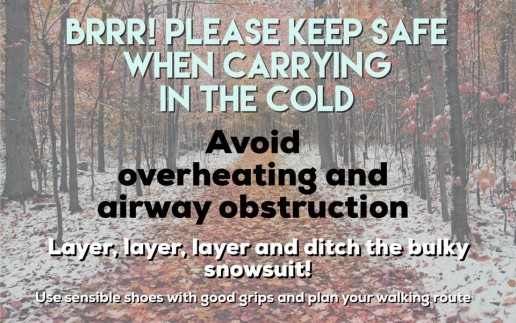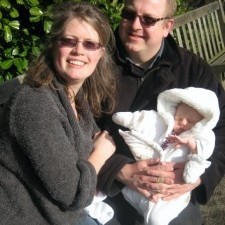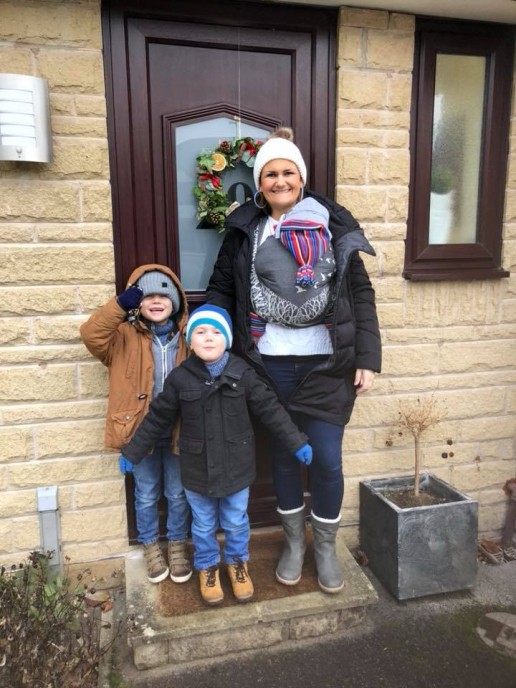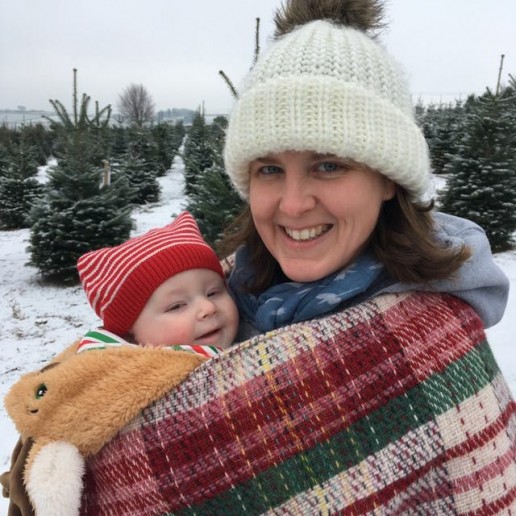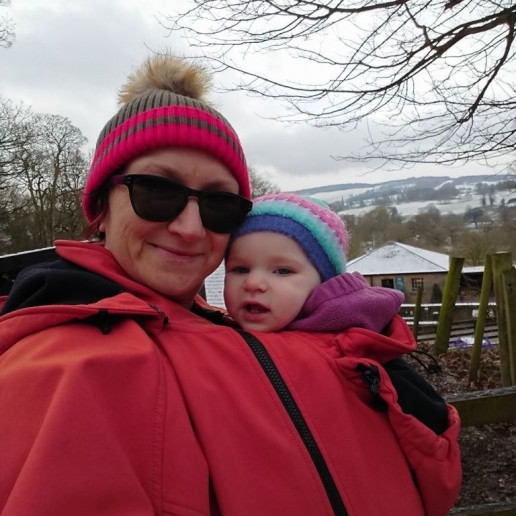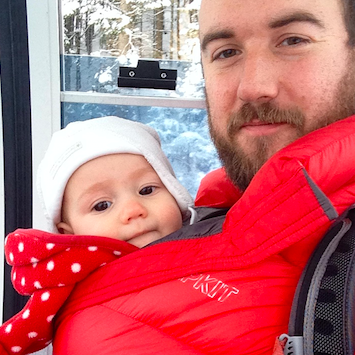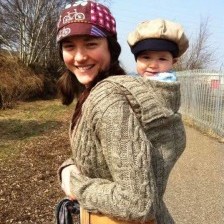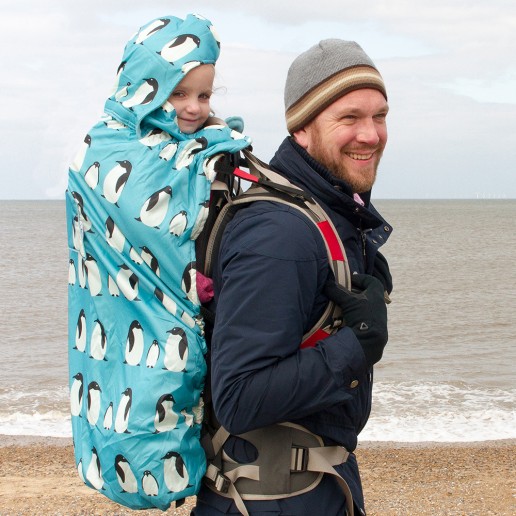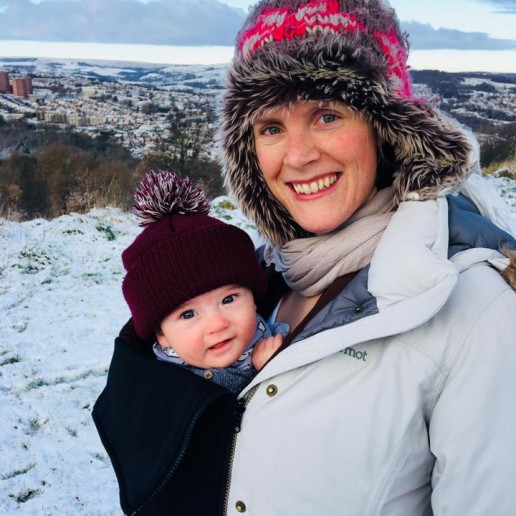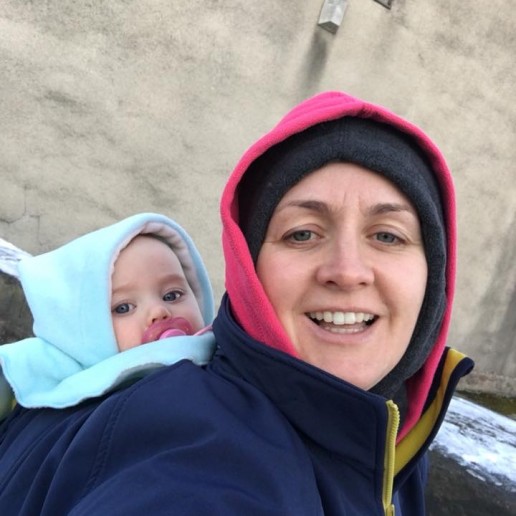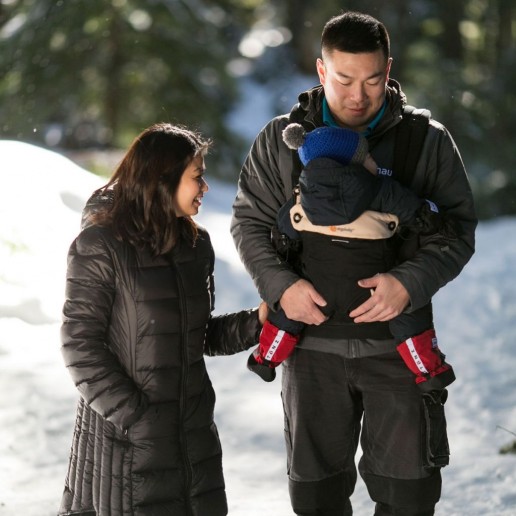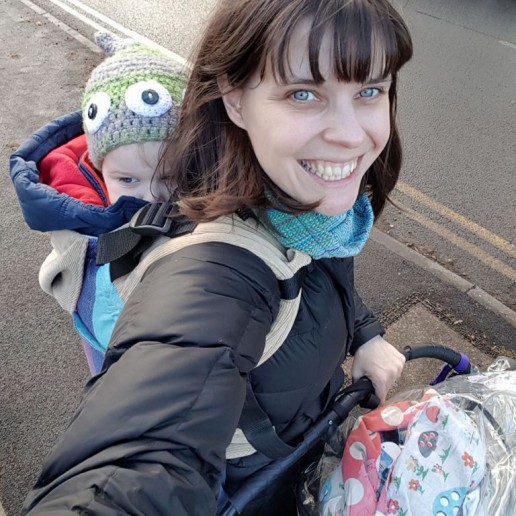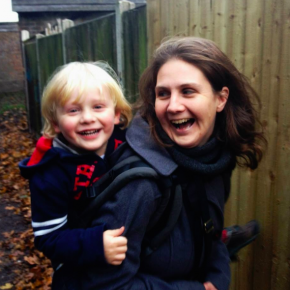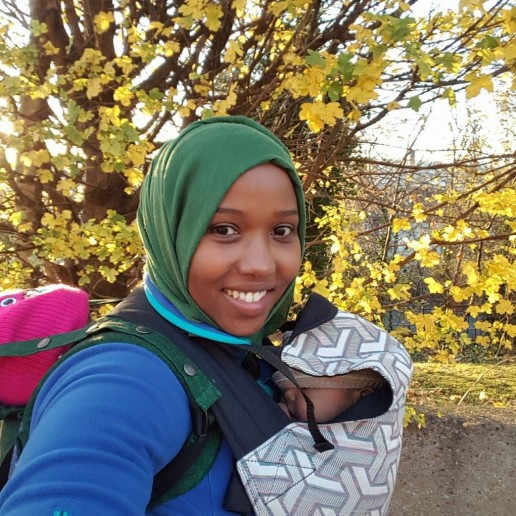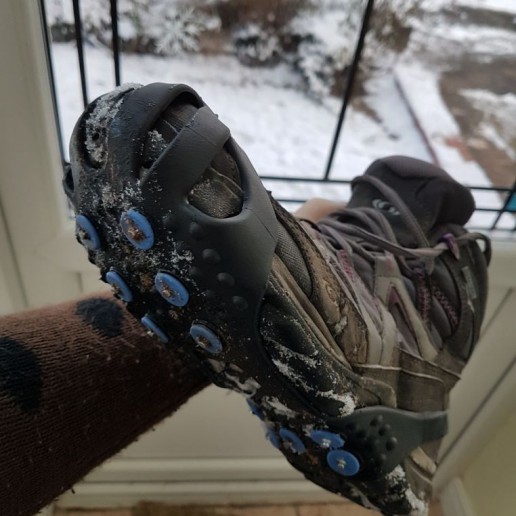Autumn and winter can be a wonderful time of year, with frosty mornings and chilly walks, the first snowfall, and a little child nestled cosily up to you. Fresh air is good for the soul, and exercise and changes of scenery can make a big difference to family life. You don't need to be afraid of wintry weather, in fact, a baby carrier can help you go places!
It is important to consider safety in all things, and dressing warmly for winter while using a sling/carrier is no exception. Snowsuits may be cute and warm but they need to be used carefully.
When the weather turns chilly, or even icy, every caring parent’s mind turns to how to keep their baby warm in the cold air. Out come the snuggly snowsuits and the hooded jackets, out come the warm cosy scarves and thick cardigans, all aimed to keep you and baby toasty warm. At sling library sessions I can often be found encouraging parents to undress their babies, and often themselves! But why? Surely warmth is important?
Indeed it is, and it is good to be aware of your child’s needs. But there is often still a question about the best way to keep warm when you are using a sling… are the snuggly snowsuits really the best option? Are they safe to use, especially with the current advice about avoiding thick coats in car seats? (see the link at the bottom).
I see a lot of parents with small babies (under four months) in snowsuits or thick jackets who are then settled into a carrier, be it a stretchy or woven wrap or a meh dai or a buckle carrier. Problems can arise at this point; baby is often too warm, and may be rather sleepy as a result, or irritable, and the parent may be finding the carrier uncomfortable. Babies under 4 months are at greatest risk of difficulties due to their relative smallness weakness; they do not have strong and sustained head, back and torso control, so are more likely to run into problems. Older babies and toddlers are very different!
Let’s look at some of the major factors to consider when using a carrier in the cold.
1) Be aware of OVERHEATING
Too many thick snuggly layers can be a risk of overheating. Babies are by nature warm little creatures (carrying them can feel like having a delightful wriggly hot water bottle on your front) and it is their extremities and their heads that need protecting much more than their middles. They are not yet able to regulate their own temperatures in the way that adults can (which is why skin to skin contact from an adult for a feverish or cold child can be so very useful) so being close to your body will rapidly warm a child up anyway. As you walk you will warm up, and your extra heat will warm up the child on your front even more.
Being too hot is not good for babies; it makes them sleepy and overbundling a sleeping baby is a risk for SIDS (sudden infant death syndrome). It makes sense to avoid this overheating in slings just as much when baby is sleeping in a bed or a car seat. Furthermore, being too bundled up reduces their ability to sweat (the drops of sweat need to be able to evaporate to carry heat away) which means even older children who can regulate their temperature better will also struggle with being too hot. Hot babies are at significant risk; it is relatively easy to add extra layers for warmth if you misjudge slightly and to remove them when you come in out of the cold.
.
2) Be aware of AIRWAY
Sometimes the weight of baby inside the snowsuit can mean they sink down inside it, due to gravity, and end up with their faces buried inside the body of the snowsuit. This may pose a risk to airway and breathing; the same goes for hooded jackets or thick cardigans that can “ride up” the back of the carrier.
Too much fabric around the chest and upper body will also make it hard to achieve a fully supported back and a tight carry. This may increase the risk of too much space between baby’s head and your chest, allowing his chest to curl and compress and his heavy head to slump forwards, potentially compressing his airway, or burying his face into fluffy fabric, reducing airflow. Thick snowsuits really can be a significant risk.
Always ensure good airflow. Be aware of your own clothing too; a cowl or a scarf may prove problematic if your baby snuggles his face into the fabric, reducing free airflow. This is more of a risk with smaller babies than in those who have head control and are able to move themselves independently.
Make sure your baby’s face is not obscured by scarves or fabric that could be problematic if they fall asleep.
This little boy is too small for his snowsuit; if he was placed inside a sling his face would disappear into the fluffiness.
3) Be aware of POSITION
Increased bulk can affect positioning considerably. It is hard for joints to bend easily in thick, stiff trousers or multiple layers of clothing, so the M shape with bent knees higher than bottom that encourages healthy hips and protects the natural curve of the spine into a J shape can be hard to achieve. Baby may end up being “starfished” into a carrier with a hyperextended posture, rather than being comfortably seated.
 This will affect how his pelvis and spine are positioned and may mean that his neck is not naturally supported by the J shaping that is achieved by ergonomic carriers. (This is why many narrow-based high-street carriers need prominent neck support or headrests, as baby is held straight and the head can more easily fall back).
This will affect how his pelvis and spine are positioned and may mean that his neck is not naturally supported by the J shaping that is achieved by ergonomic carriers. (This is why many narrow-based high-street carriers need prominent neck support or headrests, as baby is held straight and the head can more easily fall back).
Baby will feel heavier as he is not resting against the parent/carer’s body in the same way, and the weight distribution will change.
Too much bulk around the top may also affect the support to baby’s upper body, meaning that baby’s weight is pulling back away from your shoulders, rather than resting on your chest, and may be more uncomfortable.
Too much padding around the nappy region (especially in those babies wearing cloth nappies) could cause a reduction of blood flow to the lower limbs.
Baby above, has been straightened into a starfishing shape as the snowsuit is preventing his hips and knees from bending. however baby below is in the M shape.
OK, so this is good to know. But it’s cold out there! My baby needs to be warm, what can I do?!
Here are some suggestions how to ensure your chilly weather carrying is safe and still snuggly warm.
1) LAYER LAYER LAYER – carrying under coats
This is key to virtually all carrying, as the sling is in itself a layer of clothing, and sometimes more than one, depending on its type. A stretchy wrap is three layers, and some are thicker than others. Some buckle carriers are double layer panels, some are three. Every parent/child combination have their own micro-climate too, so what feels right for one family may be different for another.
In hot weather, you need as few as you can manage safely, whereas in cold weather you need more layers. Layers trap air in between them, so can often be more effective at providing warmth than one or two thick items of clothing, while still allowing flexibiity.
Thin light all-in-one fleece suits are warm, while still being breathable and allowing good joint movement for positioning. It may be worth considering a size up to protect little toes with the riding up you get with a sling, however, too large a fleece could mean too much fabric around the face and neck. Layer up with vests and onesies and cardigans and leggings and so on, rather than using a very padded or furry inflexible snowsuit, you will be surprised how warm babies can get!
It is best, if possible, to keep baby as close to you as you can, and add layers on over the top. These layers can be undone/removed easily if baby is getting too hot (flushed, very warm chest skin, sweating, unexpectedly sleeping, for example), or if you go inside into a warm shop from a cold outside.
Wearing a large (maternity or oversized) coat which you can then wrap around your baby on the front will add warmth, as will a mac in rainy weather.
If you are creative, you could knit yourself a panel insert which would button onto your favourite button coat, making it wider to fit your baby and the sling inside. You can do the same with a zip insert. If you are innovative, you can use a large oversize hoodie or cardigan with a very big neck or a zip that can be undone to go over both of you, or wear an oversized coat backwards if you can get someone else to do up the zip. Others may use a large shawl to wrap around themselves, or a home-made fleece poncho.
There are many babywearing coats or ponchos or vests and other items of clothing on the market which have been specifically designed for this, such as the Mamalila, Wombat, Momawo, Liliputi coat ranges (among many others), Boba hoodies/fleece vests, to name just a few, and many are suitable for back carrying.
Some can be expensive; for many they are invaluable especially if they are used frequently for back carrying (many maternity coats or extender panels do not allow back carrying) and some are stylish enough to be worn as normal coats to make them worth the outlay. Some will have hoods for both parent and baby, some won’t – it is worth doing your homework and trying a few before you splash out.
There are also some babywearing covers, similar to pushchair covers, that can just go over baby and sling but not parent, which may be useful if the parent prefers less warmth (such as Bundle Bean or Isara).
In rainy weather, some will use large anoraks over both baby and parent. There are several waterproof ponchos or covers on the market which can go over the sling on the top and umbrellas are very useful. Some creative folks have even threaded the arms of cross strap buckle carriers through a child’s waterproof anorak to cover over the panel!
2) PROTECT EXTREMITIES
So if your baby’s body is nice and warm, heads and limbs need to be kept warm too.
This is where things like baby leggings, tights and socks can be very useful indeed, layering up over the feet. Some people find boots helpful as well, such as Stonz or Thinsulate boots (varying price ranges) or wooly booties that can be tied gently on to avoid falling off. Some fleece onesies have feet that can be folded over to make a closed foot. Feet can get much colder than hands as they are harder to tuck in near the warm central core.
Heads can be kept warm with hats…(of which there are many gorgeous options). Some opt for balaclavas with neck covers and various hoods to keep necks warm and prevent removal!
Hands can be kept warm with gloves with ribbons sewn in to stop them from falling off, or socks worn on the hands. Many fleece onesies have sleeves that can be folded over hands.
3) MANAGING CARRYING OVER COATS
This tends to work better for older babies or toddlers who want to be up and down all the time, and can work well in some circumstances, depending on the coat, the carrier and if you have anyone to help you. It can be hard to get a sling snug over the top of a bulky or slippery coat, and hard to get a snug fit on the back without help, but for many this works well.
Taking some care when planning the coat you use will make a big difference, (one that is thin and grippy, for example may be easier to work with, and hoods may get in the way of unobstructed breathing). Selecting the sling you use matters too; what you choose for normal use for maximum comfort may prove too complex over a coat. Pick one that is easily adjustable, and easy to get on and off.
This style of carrying over coats on the back may be much more convenient for toddlers who prefer to be able to get up and down again in quick succession. They are more likely to get cold on your back as they cannot snuggle into your body heat in the same way, so will need to be much more warmly dressed than a smaller baby on the front. This is especially true for framed carriers that hold children high up and separate. These children are not at the same risk of slumping over inside over-large suits and ending up with an obstructed airway, and as they are outside your coat, they will get cold. Snowsuits (that fit and are still flexible) can be an excellent solution here, as can waterproofs over coats and snuggly trousers.
Hands and feet will get a lot colder with this type of carrying, so make sure you are prepared.
CARRYING IN SLIPPERY WEATHER
It is fantastic to be able to explore in freedom with your child in all weathers. But what about, even if you have the choice of sling and clothing right, the ground is icy and slippery?
CHOOSE SENSIBLE FOOTWEAR!
If carrying in the snow and ice, slip-on ice gripping covers (eg Yaktrax or other brands) that can go over shoes and boots can be enormously useful to prevent slipping… and if you do slip, your baby will be much safer in the sling than she would be loose in arms. Some metal grippers may not work well on mixed ground, as they may slide on smooth surfaces and can be hard to remove quickly, so have a good look at a few types and where you will need to use them before you pick one. It can be hard to remove them with a baby on your front, so plan ahead!
Good boots with grippy soles designed for all terrains may be worth investing in. Some families have used very large knitted socks over their shoes for grippiness over snow and ice when they know there are also stone stairs etc on the school run and they don’t want to go flying.
Some people recommend front carrying more in slippery weather, as if you do fall, you can use your hands to break your fall and protect your child more easily than if you fall backwards. Some people prefer not to carry at all and to use a buggy! Use whatever tool works best for your circumstances.
Here is some more information about cold weather carrying from other sources
http://southlondonslings.co.uk/2013/11/12/carrying-in-the-cold/ and
http://stroudslingmeet.wordpress.com/2014/09/20/slinging-in-the-rain-and-cold-and-wind-and-snow/
Here is the link discussing winter coats and car seats..
Blog post originally written 2014, updated Dec 2017

